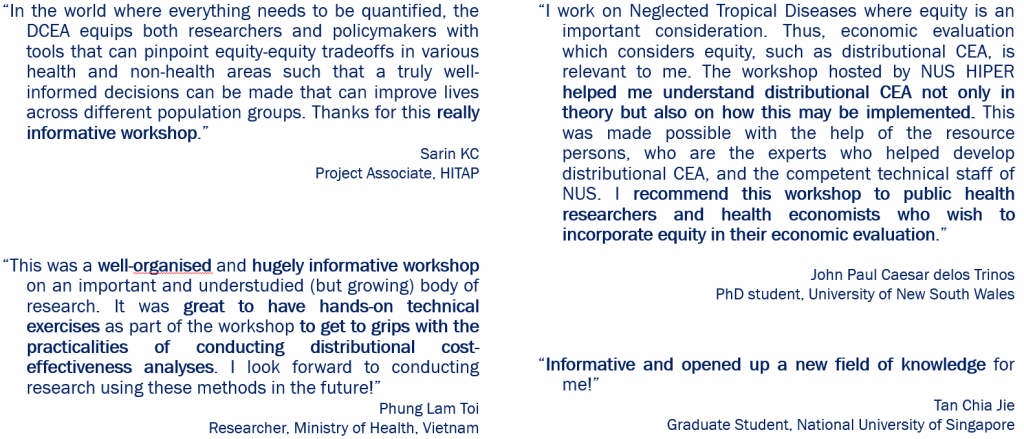course-dcea
- Home
- course-dcea
Post-workshop Report
SHORT COURSE: DISTRIBUTIONAL COST-EFFECTIVENESS ANALYSIS
Date: Monday, 19 April – Friday, 23 April 2021
Written by Richard Tan
Summary
In a standard health economic evaluation, the goal is to identify cost-effective interventions that maximises total health. However, a distributional cost-effectiveness analysis (DCEA) model builds upon the standard cost-effectiveness model by incorporating the distributional impacts of health. This allows us to incorporate equity considerations into our analysis. By modelling the changes to the baseline health distribution of a general population that arise due to the health interventions in consideration, and incorporating various sources of inequality, the DCEA framework not only allows us to estimate the change in health outcome, such as the Health-Adjusted Life Years (HALYs), of each intervention, but also how each decision will change the level of unfair inequality that affects the population in question. The DCEA framework then combines these with the relevant social welfare function and leverages on the equity impact plane to help decision makers determine which intervention is most relevant in maximising health and minimising unfair health inequality.

Group photo with the lecturers and participants. The course was attended by 37 participants from Laos, Nigeria, Philippines, Rwanda, Singapore, Thailand, United Kingdom and Vietnam
How do you feel about the course?
This was an illuminating course. I liked the way it introduced, in a structured manner, another dimension to how CEA can be conducted. In this case – incorporating distributional impacts of health into a traditional CEA model so that we can analyse the trade-off between maximising total health and reducing inequalities between different intervention strategies.
The course demonstrated that upon the inclusion of equity considerations, it is possible that you end up with a very different result from that of a standard CEA. In my opinion, this will have considerable implications for decision makers, since they will be able to understand how interventions will impact population groups differently, and can choose one, or (re)design one, such that it best aligns with their priorities. Considering the current pandemic, and how the damage left by the COVID-19 virus sheds light on the health inequalities that persist in our communities, this form of CEA will become ever more critical for decision makers to understand so that they can make the most effective decisions that not only improve the health of the population, but attempt to close the health inequalities that plague communities.
I also enjoyed this course because the professors not only expounded on arguments to consider the DCEA, but they also described the methods, discussed the necessary data-requirements, and provided a hands-on opportunity to build a simple DCEA model, in which I could relate the ideas and understand them with relative ease. Overall, it was a great introductory course with excellent faculty teaching it.
What Other Participants Say About This Course



